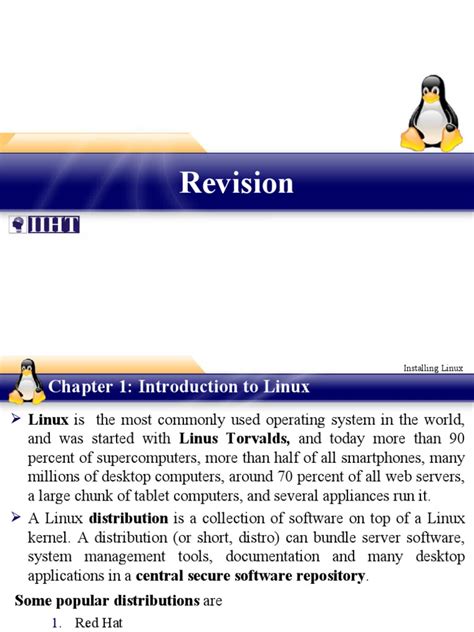As technology continues to advance, so does the need for robust security measures to protect our digital assets. In the ever-evolving landscape of software development, it is vital to ensure that your applications remain protected from potential threats and vulnerabilities. One powerful tool that can help you in this endeavor is AppArmor – an indispensable framework that enhances the security posture of your Linux-based infrastructure.
AppArmor works by enforcing a set of security policies, also known as profiles, which define the permissions and restrictions for individual applications. By strategically restricting an application's access to sensitive system resources, AppArmor mitigates the risk of unauthorized access, malicious manipulation, or potential data breaches.
Within this comprehensive guide, learn how to effectively configure and implement AppArmor on your Linux system, empowering you with the means to strengthen your application and system security. From understanding the core concepts and benefits of AppArmor to deploying customized profiles tailored to your specific requirements, this article equips you with the knowledge and skills to take proactive measures in securing your digital ecosystem.
Understanding the Power of AppArmor and its Advantages

When it comes to securing your Linux environment, one cannot underestimate the importance of AppArmor and the numerous benefits it brings along. AppArmor, a robust security framework, provides an additional layer of protection to your system by confining individual applications within predefined boundaries, known as profiles.
By gaining a deep understanding of AppArmor and harnessing its potential, you can elevate the security posture of your Linux-based systems to new heights. Rather than relying solely on traditional security measures, such as user-based permissions or traditional access control mechanisms, AppArmor empowers system administrators with fine-grained control over application behavior on a per-profile basis.
Enhanced Application Isolation: By confining applications within well-defined profiles, AppArmor ensures that even if an application is compromised, the potential damage it can cause is limited. This isolation prevents unauthorized access to critical files and directories, protecting sensitive data from being tampered with or leaked.
Reduced Attack Surface: AppArmor significantly reduces the attack surface of your Linux system by blocking access to resources that applications don't need. By limiting an application's capabilities to only what is required, it minimizes the opportunities for attackers to exploit potential vulnerabilities.
Built-in Default Profiles: AppArmor comes with a set of default profiles for commonly used applications, which means you don't have to start from scratch when securing your system. These pre-defined profiles can be customized and tuned as per your specific requirements, providing a head start in hardening your system against potential threats.
Seamless Integration and Flexibility: AppArmor seamlessly integrates with the Linux kernel and provides a flexible framework that can be easily adapted to suit your environment's needs. Whether you are running a single system or managing a vast network of Linux machines, AppArmor can be deployed across various scenarios, ensuring consistent protection across your entire infrastructure.
Protection against Zero-day Threats: AppArmor's proactive approach towards security helps defend your system against zero-day threats. By restricting applications to their intended functionality, even unknown vulnerabilities are mitigated, reducing the chances of successful exploitation.
In conclusion, AppArmor serves as a powerful tool in your arsenal for securing Linux systems. With its application confinement capabilities and comprehensive security features, it offers enhanced application isolation, reduced attack surface, built-in default profiles, flexibility, and protection against emerging threats. By amplifying your understanding of this security framework, you can maximize the benefits it provides and fortify your Linux environment against potential risks.
Securing Your Operating Environment with AppArmor
Setting up AppArmor to enhance the security of your Linux operating environment is a crucial step in protecting your system from unauthorized access and potential attacks. This section will guide you through the process of configuring and implementing AppArmor to create an additional layer of defense for your system.
- Understanding AppArmor: Gain insights into the concept and functionality of AppArmor, a powerful security framework for restricting the capabilities of applications within a Linux system.
- Identifying Security Requirements: Assess your system's specific security needs and determine which applications should be secured using AppArmor. Define the level of access each application should have to your system's resources.
- Configuring AppArmor Profiles: Learn how to create, modify, and manage AppArmor profiles for different applications. Customize the restrictions and permissions according to your requirements.
- Enforcing AppArmor Policies: Explore how to enforce the AppArmor policies you have defined. Ensure that the restrictions are in effect and actively preventing unauthorized access and potentially harmful actions.
- Testing and Troubleshooting: Implement comprehensive testing procedures to validate the effectiveness of your AppArmor setup. Troubleshoot any potential issues or conflicts that may arise during the process.
By following the guidelines and best practices outlined in this section, you can establish a robust AppArmor configuration that significantly enhances the security of your Linux system. Safeguard your data, applications, and overall operating environment from potential threats and maintain peace of mind.
Introduction to Installing and Enabling AppArmor on a Linux Distribution

In this section, we will explore the process of setting up and activating AppArmor, a powerful security framework designed to enhance the protection of applications on a Linux-based operating system. By implementing AppArmor, you can enforce fine-grained controls and restrictions on application behavior, safeguarding against potential vulnerabilities and unauthorized access. Through a step-by-step guide, we will cover the essential steps to install and enable AppArmor on your Linux distribution, ensuring that your system is fortified with an additional layer of defense.
To commence the installation and activation of AppArmor, we first need to ensure that all the necessary prerequisites are met. This involves verifying the presence of compatible kernel support, as well as ensuring the availability of required packages and modules. Once these requirements are fulfilled, we can proceed with the installation process, which typically involves utilizing package managers or manual configuration. Subsequently, we will explore the crucial task of enabling AppArmor, configuring it to work in conjunction with the specific applications or services you wish to protect. This entails defining security profiles and assigning them to the desired programs, specifying the allowed and denied actions for each.
Additionally, we will delve into the different techniques for managing and monitoring AppArmor once it is successfully installed and enabled. This includes the ability to examine and modify existing profiles, as well as creating custom profiles tailored to the unique requirements of your system. We will also discuss techniques for diagnosing and troubleshooting any issues that may arise during the setup process or while utilizing AppArmor. By familiarizing yourself with these management and troubleshooting strategies, you will gain the capability to effectively maintain the security and integrity of your Linux system, ensuring the continued protection of your applications and data.
In conclusion, by following the instructions provided in this section, you will be equipped with the knowledge and skills necessary to install, enable, and effectively utilize AppArmor on your Linux distribution. By employing this robust security framework, you can significantly enhance the overall defense of your system, minimizing the risk of malicious attacks and unauthorized access. Ready to bolster the security of your Linux environment? Let's get started with the installation and activation of AppArmor!
Creating and Managing AppArmor Profiles
In this section, we will explore the process of creating and managing AppArmor profiles on a Linux-based operating system. AppArmor is a security framework that allows users to define and enforce fine-grained access control policies for individual applications or processes. By creating custom AppArmor profiles, users can specify the permissions and restrictions that should be applied to specific applications, thereby enhancing the overall security of their system.
When creating an AppArmor profile, it is important to carefully consider the specific needs and requirements of the application or process in question. By analyzing the potential risks and vulnerabilities associated with the application, users can establish a set of restrictions that will effectively mitigate these risks. This involves identifying the various resources that the application needs to access, such as files, directories, network resources, and system services, and determining the appropriate level of access that should be granted or denied.
Once the initial profile has been created, it can be further managed and fine-tuned based on ongoing analysis and monitoring. This may involve adding additional rules to the profile to address new security concerns that arise, or modifying existing rules to refine the access control policies. Regularly reviewing and updating the AppArmor profiles is essential to ensure that they remain effective and up-to-date in protecting against potential security threats.
Managing AppArmor profiles also involves troubleshooting and debugging any issues that may arise. Through the use of diagnostic tools and logs, users can identify any conflicts or errors in the profile and take appropriate actions to resolve them. This may include adjusting the permissions, modifying the rules, or seeking assistance from the AppArmor community for guidance.
Overall, creating and managing AppArmor profiles is an integral part of maintaining a secure Linux system. By customizing the access control policies based on the specific requirements of each application or process, users can significantly enhance the overall security posture of their system and protect against potential threats or unauthorized access.
Defining Policies for Specific Applications

In this section, we will delve into the process of customizing AppArmor policies to enhance the security of individual applications on a Linux system. By tailoring the policies to specific applications, we can ensure that only authorized actions are allowed, preventing unauthorized access and potential security breaches.
- Identifying the target application: The first step in defining a policy for a specific application is to identify the application that requires enhanced security measures. This could be any software or service running on your Linux system.
- Understanding the application's behavior: Before defining the AppArmor policy, it is crucial to gain a thorough understanding of how the application operates. Analyze its functionalities, interactions with other system components, and potential vulnerabilities.
- Defining access permissions: Once you have identified the target application and understood its behavior, you can proceed to define the access permissions for the application. This involves determining what resources the application should have access to and what actions it should be allowed to perform.
- Creating the AppArmor profile: With the access permissions defined, you can now create the AppArmor profile for the specific application. This profile will serve as a set of rules that govern the application's actions and interactions, ensuring that it adheres to the defined access permissions.
- Testing and refining the policy: After creating the initial AppArmor profile, it is essential to thoroughly test it to ensure that it effectively restricts unauthorized actions without hindering the application's functionality. Iterate on the policy as needed to achieve the desired balance between security and usability.
- Monitoring and updating the policy: Lastly, it is crucial to regularly monitor the application's behavior and review the AppArmor policy to identify any changes or updates required. As the application evolves or new vulnerabilities emerge, adapting the policy will help maintain its effectiveness in protecting against potential threats.
By following these steps and customizing AppArmor policies for specific applications, you can significantly strengthen the security of your Linux system and mitigate the risks associated with potential security breaches.
Testing and Troubleshooting AppArmor
In this section, we will explore various techniques for testing and troubleshooting the functionality of AppArmor, a security framework used to restrict the capabilities of applications in a Linux environment. By thoroughly examining and addressing any issues that may arise, you can ensure the proper functioning of AppArmor and enhance the overall security of your system.
1. Reviewing AppArmor Profiles:
- Inspect the existing AppArmor profiles on your system.
- Verify that the profiles are correctly configured and cover all the necessary applications.
- Identify any potential gaps or misconfigurations.
2. Testing Profile Enforcement:
- Create a test scenario to evaluate AppArmor's enforcement of a particular profile.
- Simulate an attempted violation of the profile's restrictions.
- Observe whether AppArmor successfully detects and blocks the unauthorized actions.
3. Debugging Profile Issues:
- Utilize the AppArmor debugging tools to identify and resolve any issues with profiles.
- Enable debugging mode and review the generated logs for relevant information.
- Investigate any denials or warnings reported by AppArmor.
4. Managing AppArmor Notifications:
- Configure the notification settings to receive alerts when AppArmor blocks a restricted action.
- Monitor the notifications to identify any false positives or areas requiring further fine-tuning.
- Adjust the notification configuration as needed to maintain an optimal balance between security and usability.
5. AppArmor in Combination with Other Security Features:
- Explore how AppArmor interacts with other security mechanisms, such as SELinux or Mandatory Access Control (MAC) systems.
- Verify that these components work harmoniously together to provide comprehensive protection.
- Resolve any conflicts or compatibility issues that may arise.
By following these testing and troubleshooting steps, you can ensure that AppArmor operates reliably and effectively on your Linux system, bolstering its overall security posture and safeguarding your critical resources and data.
Protect Your Ubuntu System with AppArmor & Firejail [Tutorial]
Protect Your Ubuntu System with AppArmor & Firejail [Tutorial] by Null Byte 48,577 views 4 years ago 12 minutes, 36 seconds
FAQ
What is AppArmor and why should I consider setting it up on my Linux system?
AppArmor is a Linux security module that restricts programs' capabilities by enforcing security policies. By setting up AppArmor on your Linux system, you can add an extra layer of protection by confining specific applications and preventing potential security breaches.
How can I check if AppArmor is already installed on my Linux system?
To check if AppArmor is installed on your Linux system, you can use the command "sudo apparmor_status". This command will display the status of AppArmor and list any enforced security profiles.
Can I set up AppArmor for specific applications only, or does it apply to the entire system?
Yes, you can set up AppArmor for specific applications. AppArmor allows you to create unique security profiles for individual programs, confining their access to certain files, directories, and resources. This way, you can customize the level of protection for each application according to your needs.
Are there any graphical tools available to help me set up AppArmor?
Yes, there are graphical tools available for setting up AppArmor. One popular tool is the "AppArmor Easy Profiling" tool, which provides a user-friendly interface for creating and managing AppArmor profiles. Additionally, some Linux distributions may provide their own graphical tools or integrations for managing AppArmor.




